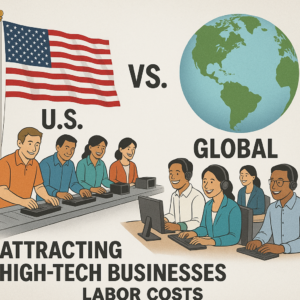How U.S. Tech and Pharma Giants Leverage Tax Policy to Invest Abroad—At America’s Expense
Published on June 12, 2025
From Silicon Valley to the global stage, U.S.-based technology and pharmaceutical companies have redefined innovation—and tax strategy. Between 2000 and 2017, companies like Apple, Google, Pfizer, and Johnson & Johnson leveraged complex international tax loopholes to lower their effective tax rates, often below 10%. While technically legal, these practices had major economic consequences for the United States, particularly in terms of lost domestic investment and jobs.
In this article, we’ll explore the core tax strategies these corporations used, the impacts on the U.S. economy, and whether the system ultimately benefited or hurt the nation. This deep dive into U.S. tax policy regarding large U.S. tech and pharma companies highlights what was lost—and what could change.
How Tech and Pharma Corporations Reduced Taxes Before 2017
1. Profit Shifting and Offshore Havens
One of the primary tools was profit shifting, moving income to subsidiaries in tax-friendly jurisdictions like Ireland, Luxembourg, and Bermuda. These countries offered ultra-low corporate tax rates—sometimes below 5%—compared to the U.S. corporate tax rate of 35% (pre-2017).
Apple’s “Double Irish with a Dutch Sandwich” strategy became the most famous example, helping it defer U.S. taxes on billions in global profits.
Pharma companies followed similar playbooks, assigning patents to offshore entities and having U.S. operations pay royalties, keeping profits outside the reach of the IRS.
2. Deferred Tax Liabilities and the “Repatriation Trap”
Until the 2017 Tax Cuts and Jobs Act (TCJA), U.S. law allowed corporations to defer taxes on foreign profits until they were brought back to the U.S.—a policy that discouraged repatriation and encouraged offshore reinvestment.
By 2017, U.S. multinationals had accumulated over $2.6 trillion in untaxed foreign earnings. This capital was not idle—it was used to build factories, data centers, and offices abroad, especially in low-tax, low-cost nations.
3. R&D Tax Credits
While R&D tax credits incentivized innovation, they also further reduced effective tax rates. Combined with profit shifting, this created a system where corporations paid little tax at home while expanding aggressively overseas.
Offshore Investment Boom: The U.S. Missed Out
Why Profits Didn’t Return to the U.S.
The combination of high U.S. corporate tax rates and permissive offshore policies made it financially irresponsible—for these companies—to reinvest at home.
Corporations instead used foreign-held earnings to:
- Build manufacturing plants in Ireland and Singapore
- Hire skilled labor at lower wages in India and Eastern Europe
- Acquire overseas competitors and assets
- Avoid regulatory burdens found in the U.S.
Case in Point: Pfizer’s Attempted Inversion
In 2015, Pfizer tried to merge with Allergan in a $160 billion deal designed to re-domicile in Ireland. Though eventually blocked, the move underscored how American tax policy incentivized exit strategies over domestic reinvestment.
What the U.S. Lost
From 2000 to 2017, U.S. tax laws effectively encouraged global expansion at the expense of domestic economic growth. The losses included:
- ❌ Thousands of American jobs—especially in high-skill tech and pharmaceutical manufacturing
- ❌ Capital expenditures like factories and data centers that went abroad
- ❌ Property taxes and local investment that would have benefited U.S. cities and counties
- ❌ Strength in strategic supply chains, especially in critical drug ingredients and semiconductors
Benefits of Low Corporate Tax Rates (The Case For)
✅ Innovation Acceleration
Tax savings were used to fund long-term R&D, particularly in:
- Artificial Intelligence (AI)
- Biotechnology and gene therapy
- Cloud infrastructure and computing
✅ Global Competitiveness
Lower effective rates made it easier for U.S. corporations to compete internationally, especially against rivals based in low-tax countries.
✅ Capital Market Growth
Shareholders benefited. Companies used overseas profits for stock buybacks and dividends, boosting the S&P 500 and increasing portfolio value for millions of Americans.
Downsides of the Tax Strategy (The Case Against)
❌ Shrinking the U.S. Tax Base
According to the Institute on Taxation and Economic Policy, at least 55 large U.S. corporations paid zero federal income tax in 2020. This meant:
- Fewer public services
- Higher relative taxes on small businesses and middle-class workers
❌ Creating an Uneven Playing Field
SMEs (Small and Medium Enterprises), which lack offshore subsidiaries, couldn’t match the tax engineering of giants like Apple or Pfizer. This stifled entrepreneurship and widened the economic gap.
❌ Offshore Investment > Domestic Growth
Billions in foreign plants, jobs, and infrastructure could have revitalized American regions hit hard by deindustrialization.
❌ Undermining Public Trust
The idea that trillion-dollar companies contribute little to national revenue undermines the public’s belief in economic fairness.
Tax Reform and the Future
TCJA’s Mixed Impact
The 2017 Tax Cuts and Jobs Act:
- ✅ Lowered the corporate tax rate from 35% to 21%
- ✅ Introduced a global minimum tax on intangible income (GILTI)
- ❌ Failed to fully close loopholes or stop capital flight
While the TCJA repatriated some earnings, the structure still rewards foreign expansion under current global rules.
The Global Minimum Tax Push
Efforts by the OECD and G20 to implement a 15% global minimum tax aim to neutralize tax haven advantages and redirect capital to domestic use. Adoption in the U.S. remains politically contested.
Conclusion: Was It Worth It?
Between 2000 and 2017, U.S. tax policy created a system where the largest corporations thrived globally but reinvested less in their home country.
While the innovation economy flourished, the cost to American jobs, infrastructure, and fiscal equity was enormous.
Moving forward, tax policy must strike a balance between:
- Encouraging innovation and global competitiveness
- Ensuring that profits generated abroad ultimately benefit the American people



